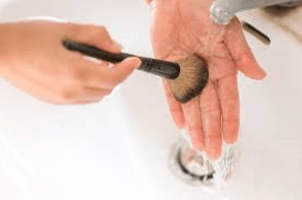Makeup brushes are essential tools in any beauty enthusiast’s collection, but they often don’t receive the proper care they deserve. Learning the best way to clean makeup brushes effectively isn’t just about maintaining their performance—it’s about protecting your skin health too.
When makeup brushes accumulate product, oils, and bacteria over time, they can lead to breakouts, uneven application, and a shorter lifespan for your precious tools. As someone who has tested countless cleaning techniques over the years, I’ve compiled the most effective approaches that balance thoroughness with gentleness to ensure your brushes stay soft and functional for years to come.
Let’s discover how simple changes to your routine can make a significant difference.
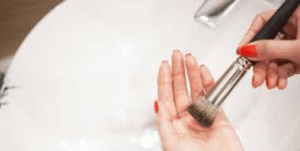
Why Cleaning Your Makeup Brushes Matters
It’s important to understand why keeping your makeup brushes clean is so crucial:
Health Benefits
- Avoids bacterial collection that can lead to skin infections and acne.
- Reduces risk of pink eye and other eye infections when using eye brushes
- Minimizes exposure to potentially harmful mold and fungus
Makeup Application Benefits
- Ensures smooth, even application of products
- Prevents color mixing and muddiness
- It helps maintain the desired finished look of your products
Brush Longevity Benefits
- Extends the lifespan of your brushes
- Preserves bristle softness and shape
- Protects your investment in quality tools
Makeup artists recommend cleaning brushes used for liquid products at least weekly, while powder brushes can typically go 2-3 weeks between deep cleanings. However, your personal usage and skin sensitivity might require more frequent cleaning.
Essential Supplies for Cleaning Makeup Brushes
To properly clean your makeup brushes, gather these supplies:
Cleaning Solutions
- Gentle brush cleanser or shampoo
- Dish washing liquid (for brushes used with oils or silicone products)
- Baby shampoo (for natural hair brushes)
- Specialized brush cleaning soaps
Tools
- Textured cleaning mat or silicone cleaning glove
- Brush cleaning egg or palm tool
- Small shallow bowl or plate
- Clean towel for drying
- Brush guard protectors for reshaping
Optional Items
- Rubbing alcohol (for sanitizing between deep cleans)
- Brush drying rack
- Brush trees for upside-down drying
Having these supplies ready before you begin will streamline the cleaning process and ensure you achieve the best results possible.
How to Clean Makeup Brushes
Method 1: Traditional Deep Cleaning
Preparation Stage
- Collect every brush that need cleaning.
- Add lightly warm water to a small bowl
- Use a little amount of mild cleanser
Cleaning Process
- Wet the brush bristles with lukewarm water while the handle and ferrule remain dry.
- Brush tips should be swirled in the cleanser mixture.
- The bristles should be gently massaged between your fingers or on a rough cleaning mat.
- Rinse thoroughly until water runs clear
- Squeeze excess water from bristles
- Reshape brush head to its original form
- Lay flat to dry or hang upside down on a brush tree
Drying Tips
- Never stand wet brushes upright as water can seep into the ferrule
- Before using again, let brushes dry thoroughly.
- When drying, stay out of direct sunshine and heat sources.
This method works excellently for both synthetic and natural hair brushes and should be your go-to for deep cleaning.
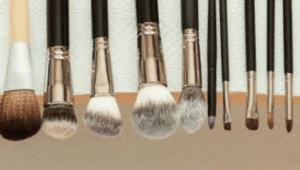
Method 2: Quick Spot Cleaning
For times when you need to switch colors or clean a brush between full washes:
Supplies Needed
- Brush spot cleaner spray
- Clean paper towel or microfiber cloth
Process
- Spray the spot cleaner directly onto the paper towel
- Move the brush gently (back and forth) over the moistened area.
- Continue swirling until no more color transfers
- Let the brush dry for 1 to 2 minutes before using again.
This method is perfect for extending time between deep cleans and is especially useful for eye brushes when switching between different eyeshadow colors.
Method 3: Sanitizing Makeup Brushes
For added protection against bacteria:
Supplies
- 70% isopropyl alcohol
- Small spray bottle
- Clean paper towel
Process
- After regular cleaning and drying, lightly mist bristles with alcohol
- Allow alcohol to air dry completely
- This method can be drying on natural brushes, so, use sparingly.
This extra step is particularly important if you’ve been sick or have had an eye or skin infection.
Specialized Cleaning Tips for Different Brush Types
Different brush materials and purposes may require specialized care:
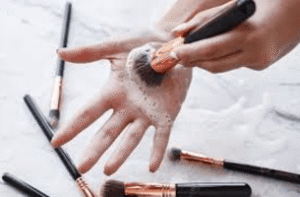 Foundation Brushes
Foundation Brushes
- These typically need more frequent cleaning due to product buildup
- Double-cleanse if necessary to remove all liquid foundation
- Use dish soap for brushes used with silicone foundations
Powder Brushes
- Gentle shampoo works best for these larger brushes
- Take extra care to rinse thoroughly
- Reshape carefully while damp to maintain fluffiness
Natural Hair Brushes
- Use gentler cleansers like baby shampoo
- Consider using a brush conditioner occasionally
- Bristles made from natural materials are prone to be more delicate, so, handle with particular care while wet
Synthetic Brushes
- Can withstand slightly stronger cleansers
- Dry faster than natural hair brushes
- Keeps in good form when being cleaned.
Artis-Style Dense Brushes
- Clean with circular motions on a textured mat
- Due to their density, brushes may need to be rinsed for a longer time.
- Go for brush cleaning solution made especially for dense brushes
Typical Errors to Avoid When Cleaning Makeup Brushes
Even with good intentions, these common mistakes can damage your brushes:
Water Temperature Issues
- The adhesive binding the bristles can be dissolved with hot water.
- Using cold water doesn’t effectively remove oils and product
Submersion Problems
- Submerging the entire brush head can loosen the ferrule
- Water entering the handle can cause wood to expand and crack
Drying Errors
- Standing brushes upright to dry causes water damage
- Delicate bristles can be harmed by using a hair dryer
- Brushes that are not reshaped when moist end up looking deformed.
Cleaning Product Mistakes
- Using harsh soaps strips natural oils from bristles
- Not rinsing thoroughly leaves residue that affects makeup application
- Using too much product wastes cleanser and requires more rinsing
Avoiding these mistakes will significantly extend the life of your brushes and maintain their performance.
How to Maintain Clean Brushes Between Washes
The time between washes can be increased by maintaining brushes properly in between major cleanings:
Daily Habits
- Keep brushes standing with the bristle side up in a clean container
- Keep brush container in a dry area away from bathroom moisture
- Tap excess product off before storing
Weekly Practices
- Spot clean brushes used with powders
- Deep clean brushes used with liquids and creams
- Sanitize handles with alcohol wipes
Monthly Maintenance
- Deep clean all brushes regardless of use
- Check for loose bristles or damage
- Assess if any brushes need replacement
Creating a consistent brush cleaning schedule makes the task more manageable and ensures you’re always using clean tools on your skin.
Professional Tips for Extending Brush Life
Makeup artists share these professional tips for extending brush longevity:
Quality Over Quantity
- Invest in fewer high-quality brushes rather than many cheap ones
- If properly maintained, high-quality brushes can last for years or even decades.
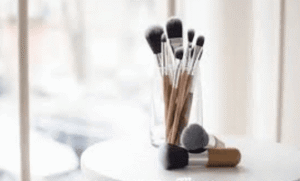
Proper Storage Solutions
- Use brush guards during travel
- Consider brush rolls for organization and protection
- Store brushes away from bathroom humidity
Rotation System
- Have backup brushes for frequently used shapes
- Rotate usage to reduce wear on any single brush
Seasonal Deep Cleaning
- Schedule quarterly ultra-deep cleaning sessions
- Consider professional brush cleaning services annually
These professional habits can transform your brush collection from a disposable expense to a long-term investment.
DIY Brush Cleaning Solutions
If you prefer making your own cleaning solutions, try these effective recipes:
Basic Gentle Cleanser
- 1 cup warm water
- 1 tablespoon mild shampoo
- 1 teaspoon olive oil (for conditioning)
Anti-Bacterial Solution
- 1 cup warm water
- 1 tablespoon mild shampoo
- 5 drops tea tree oil
Deep Cleansing Mix
- 1 part dish soap
- 2 parts olive oil
- Mix on a plate before swirling brushes
These DIY solutions can be just as effective as commercial products and often more economical for regular use.
FAQs
How often should I clean my makeup brushes?
Brushes used with liquid or cream products should be cleaned weekly to prevent bacteria growth and product buildup. Powder brushes usually don’t need to be cleaned for two to three weeks.
However, cleaning all of your brushes once a week is advised if you have sensitive or acne-prone skin. Professional makeup artists clean their brushes after each client to maintain hygiene standards and prevent cross-contamination.
Can I use regular shampoo to clean makeup brushes?
Yes, mild shampoos can effectively clean makeup brushes, especially natural hair brushes. Baby shampoo is particularly good as it’s gentle and designed to be non-irritating. For synthetic brushes used with heavy products like foundation or concealer, you might need something slightly stronger like a gentle dish soap.
Avoid shampoos with heavy conditioners or added fragrances as these can leave residue on the bristles that affects makeup application.
How do I dry makeup brushes properly?
Reshaping damp makeup brushes and placing them flat on a fresh towel with the bristles hanging off the edge of a counter is the best method for drying them (watch the video above) or use a specialized brush drying rack that holds them bristle-side down.
Never dry brushes standing upright as water can seep into the ferrule (the metal part), loosening the glue and eventually causing bristles to fall out.
Why are my makeup brushes still stiff after washing?
Stiff brushes after washing typically indicate residual product or cleanser remaining in the bristles. This happens when brushes aren’t rinsed thoroughly enough or when too much cleanser is used. Another possibility is that your brushes were dried improperly without reshaping them while damp.
To fix stiff brushes, rewash them with minimal cleanser and ensure you rinse until the water runs completely clear. Gently reshape the bristles with your fingers before drying properly.
Are brush cleaning devices worth buying?
Brush cleaning devices like electronic cleaners, spinning tools, or textured silicone mats can be worth the investment depending on your brush collection size and cleaning habits. Silicone cleaning mats or gloves are relatively inexpensive and very effective, while electronic cleaners are pricier but can clean and dry brushes more quickly.
Conclusion…
Learning the best way to clean makeup brushes properly is an essential skill for anyone who uses makeup regularly. By following the techniques outlined in this guide, you’ll not only protect your skin from potential irritants and bacteria but also extend the life of your valuable beauty tools.
The few minutes spent maintaining your brushes will pay dividends in improved makeup application and healthier skin. With clean brushes in your beauty arsenal, you’ll notice improved makeup application, reduced skin issues, and a longer-lasting collection of tools that continue to serve you well.
Now that you’re equipped with professional knowledge on the best way to clean makeup brushes, you can enjoy the benefits of pristine tools and flawless makeup application for years to come.

